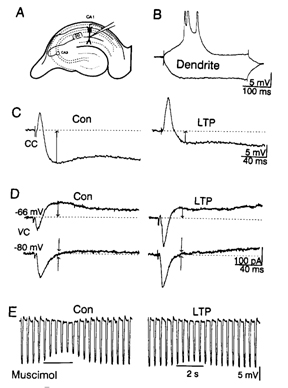
Armin Stelzer, MD, PhD
Associate Professor
Physiology and Pharmacology
Our lab studies mechanisms of activity-dependent plasticity of the central nervous system. Plasticity represents a modification of cellular and population activity in response to activation in certain brain areas. The main focus is the study of underlying mechanisms of a model of learning and memory, called long-term potentiation (LTP).
Calcium-dependent changes in the efficacy of ligand-gated receptors. Whole-cell clamp experiments are performed in acutely dissociated pyramidal cells of the hippocampus and pyramidal cells in the CA1 region of the hippocampal slice. Effects of elevation of intracellular calcium on GABAA and AMPA receptor function are measured. GABAA and AMPA receptors are the receptors mediating fast synaptic inhibition and excitation, resp. in the mammalian CNS. Sources of elevation of Ca2+ are the experimental internal perfusion of solutions containing defined Ca2+ levels and calcium transients through voltage-gated calcium channels and NMDA receptor-coupled channels. The experiments also address the biochemical mechanisms of elevation of Ca2+ in the regulation of AMPA and GABAA receptor function. Possible roles of enzymes that are known to be activated by Ca2+ are examined.
Activity-dependent changes of synaptic plasticity. Experiments in CA1 pyramidal cells of the hippocampal slice preparation examine activity-dependent long term modification of the inhibitory circuitry. Parameters of fast synaptic inhibition (IPSP, IPSC, inhibitory conductances) are measured at various points of time following application of high-frequency trains of stimuli that is known to generate long-term potentiation of excitatory responses (LTP). Intracellular recordings in CA1 pyramidal cells examine a possible role of a long-term decrease of synaptic inhibition as an underlying mechanism of pyramidal cell LTP. (see Figure 1)

Figure 1. Tetanization effects on orthodromically evoked synaptic re-sponses and iontophoretic g-aminobutyric acid-A (GABAA) responses in individual CA1 pyramidal cell apical dendrite. A: schematic depiction of dendritic recording site in CA1 stratum radiatum between 100 and 4.00 mm pelpendicular from stratum pyramidale. Test pulses and tetanic stimuli were administered to Schaffer collaterals in stratum radiatum. B: responses to hyperpolarizing (-0.2 nA, 300 ms) and depolarizing (+0.2 nA, 300 ms) current pulses. Action potentials are truncated. Recordings at resting potential (Vrest) (-66 mV). C: responses to test pulse stimulation of Schaffer collaterals recorded in current-clarnp mode before (left) and after tetanization [40 min posttetanus (PT 40), right]. Recordings at Vrest (-66 mV). D: orthodromic responses in discontinuous single-electrode voltage clamp (VC): control responses before tetanization (left) and at PT 40 (right) at 2 different holding potentials: -66 mV (Vrest top) and -80 mV [chloride reversal potential (VC1, bottom )] . Synaptic GABAAconductances calculated as chord conductances were 6 nS ( Con ) and 3.5 nS at PT 40 in the depicted dendritic recording. Test pulse stimulation intensities in C and D were 90 mA; pulse duration was 80 ms. E: responses to iontophoretic application of muscimol ( 200 mM, pH 3.5, ejecting current: +10 nA, 2 s; retaining current: -8 nA) before (left) and at PT 40 (right).
PersonnelBin Hu, M.D., Research Associate
- Stelzer, A., Slater, N. T., and ten Bruggencate, C. (1987). Activation of NMDA receptors blocks GABAergic inhibition in an in vitro model of epilepsy. Nature 326, 698-701.
- Stelzer, A., Kay, A. R., and Wong, R. K. S. (1988). GABAA receptor function in hippocampal cells is maintained by phosphorylation factors. Science 241, 339-341.
- Stelzer, A., Simon, G., Kovacs, G., and Rai, R. (1994). Synaptic disinhibition during maintenance of long-term potentiation in CA1 pyramidal cells. Proc. Nat. Acad. Sci. USA 91, 3058-3062.
- Karnup, S. V., and Stelzer, A. (1999). Temporal overlap of excitatory and inhibitory afferent input in guinea-pig CA1 pyramidal cells. J. Physiol. 516, 485-504.
- Karnup, S. V., and Stelzer, A. (2001). Seizure-like activity in the disinhibited CA1 minislice of adult guinea pigs. J. Physiol. 523, 713-730.